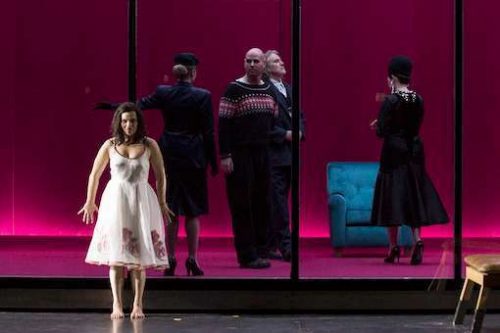
 Austria 100th Salzburg Festival – Richard Strauss, Elektra: Soloists, Concert Association of the Vienna State Opera Chorus (chorus master: Ernst Raffelsberger), Vienna Philharmonic Orchestra / Franz Welser-Möst (conductor). Review of 1.8.2020 performance (directed for the screen by Miriam Hoyer) in Salzburg’s Felsenreitschule and streamed on ARTE Concert. (JPr)
Austria 100th Salzburg Festival – Richard Strauss, Elektra: Soloists, Concert Association of the Vienna State Opera Chorus (chorus master: Ernst Raffelsberger), Vienna Philharmonic Orchestra / Franz Welser-Möst (conductor). Review of 1.8.2020 performance (directed for the screen by Miriam Hoyer) in Salzburg’s Felsenreitschule and streamed on ARTE Concert. (JPr)

Production:
Director – Krzysztof Warlikowski
Sets and Costumes – Małgorzata Szczęśniak
Lighting – Felice Ross
Video – Kamil Polak
Choreography – Claude Bardouil
Dramaturgy – Christian Longchamp
Cast:
Cyltemnestra – Tanja Ariane Baumgartner
Elektra – Ausrine Stundyte
Chrysothemis – Asmik Grigorian
Aegisth – Michael Laurenz
Orest – Derek Welton
Orest’s Tutor – Tilmann Rönnebeck
The Trainbearer – Verity Wingate
The Confidante – Valeriia Savinskaia
A Young Servant – Matthäus Schmidlechner
An Old Servant – Jens Larsen
The Overseer – Sonja Šarić
Maidservants – Bonita Hyman, Katie Coventry, Deniz Uzun, Sinéad Campbell-Wallace, Natalia Tanasii
Music events – notably opera – with audiences have been widely cancelled throughout Europe for the foreseeable future, though there has been some recent light at the end of the tunnel. There were performances outdoors in Napoli (review click here) and here the Salzburg Festival – in its 100th year – has gone ahead with a centenary celebration. I do not know what the current regulations are in Austria and whilst the audience did seem to be somewhat socially distanced, this had not apparently extended to the soloists, chorus, or orchestra. As an aside, it has been easier for countries with large land masses and relatively insignificant populations to overcomes this current pandemic easier than others and so it is totally wrong to compare what they have done which what England has suffered, but all credit to Salzburg for going ahead.
Dramaturg Christian Longchamp introduces the background to Elektra by quoting ‘I was a blackened corpse among the living, and in this hour I am the fire of life, and my flame burns up the darkness of the world’ and continues by explaining how ‘Those are Elektra’s words to her sister Chrysothemis in answer to the latter’s announcement that Orest, their long-awaited brother, has miraculously appeared and is being given a triumphant welcome, having killed, one after the other, Clytemnestra, their mother, and Aegisth, her lover and the new ruler of the city. She then speaks her last words, before collapsing, dead: “I bear the burden of joy, and I lead you in the dance. There is only one thing fitting for those who are happy as we are: to be silent and dance.” Her father’s death, the death of Agamemnon, is finally avenged. The cycle of violence is brought to an end. Perhaps the cycle of life can finally begin. In her solitary madness, entirely fixated on her father’s ghost, Elektra was like a living tomb for the hero. Elektra dies a few minutes after her mother, who was, of course, her enemy, but without whom life now no longer has any meaning, because the world of yesterday, whether adored or hated, was her only reason to live and it has disappeared forever. Only Orest and Chrysothemis will try to bring life to this devasted wasteland.’
The opera’s origins are in ancient Greek mythology, yet despite this, it is a ‘modernist opera’, as well as, an expressionist one. Hugo von Hofmannsthal and Richard Strauss’s adaptation keeps Elektra on stage all the time after her first appearance. It explores her character by revealing her emotions and psychology motivations as she meets – mostly one at a time – all the other characters, including Chrysothemis. Clytemnestra, Orest, and Aegisth. On my repeated viewing of the opera over the years, it is clear that none of these have enough time on stage for any real character development. They prove secondary to Elektra’s cries for vengeance and the plot’s tragic aftermath outlined above. There had been judicious use of Kamil Polak’s videography throughout what we had previously seen, though it came into its own as the opera ends with a mass of swirling flies against a blood-splattered backdrop. Chrysothemis calls for her brother, Orest, mirroring Elektra’s earlier cries for Agamemnon. Maybe Strauss is suggesting that the – strongly hinted at – incest will continue. What else the composer wants us to experience has always been a little obscure to me, other than perhaps ‘Beware the angry woman’. This may – or may not – have something to do with Strauss’s own apparent ‘Mommie Dearest’ issues?
In Miriam Hoyer’s direction for the screen we begin (to the accompaniment of chirruping crickets?) with a longshot of the wide-open spaces of one of Salzburg’s premier concert halls, the Felsenreitschule (literally, ‘rock riding school’). Soon we see the full extent of Małgorzata Szczęśniak’s stage design for what should be the palace in Mycenae. Here we seem to be in a slightly seedy sanatorium with a shallow pool taking up more than half of the width of the stage with an array of showers at the back. A see-through rectangular box shows the interior of the ‘palace’ where accompanying events before and during the opera can be seen. I think something was going on there during director Krzysztof Warlikowski’s prelude, but it was difficult to see but later in this additional space there are Clytemnestra’s blood sacrifice rituals and the opera’s fatal denouement, amongst much else. Truthfully, Elektra probably does not need that much direction as the setting never really changes and – for 2020 – Warlikowski’s storytelling is relatively straightforward.
It is a modern dress production; Elektra has a (blood?) red cardigan, a white dress with floral patterning at the hem, and always seems to be lighting a fresh cigarette. Her sister Chrysothemis has a shiny (rose pink?) leather-look two-piece and sports a red bra; her mother Clytemnestra is bejewelled in more red.
Just as the Ghost in Hamlet, the dead king Agamemnon is often seen as a silent witness to the bloodlust of his children, shown ever-present as three effigies on stage. Before the music even begins we also have Clytemnestra recite some words from the Oresteia – so I believe – into a microphone to put her regicide in more context. Only then did Franz Welser-Möst conjure up the opening Agamemnon motif from the Vienna Philharmonic Orchestra and we will then hear that four-note theme each time Elektra sings his name. As ever, hearing all this through laptop speakers may not entirely represent what was heard in the concert hall, though it seemed clear that Welser-Möst and his orchestra never overwhelmed the singers. From then we luxuriated in how much Strauss’s Elektra score owes to Wagner’s Ride of the Valkyries, and if that had not been composed there would be no Elektra, at least as we hear it now. It is as though the relevant pages had been put back together haphazardly with a few random ones from a couple of Viennese waltzes. We hear the Ride time, and time, and time again. For me – since I first heard it under Georg Solti in 1990 – Elektra’s music has always sounded raucous and rather relentless, and the word cacophonous comes to mind, though Strauss was never, of course, one for understatement! Though there is no doubting the raw emotions the composer allows us to see and hear.
Elektra has three central voice-shredding roles: Ausrine Stundyte’s (Elektra) was not as vocally abandoned as some can be and, as a result, hers was a nuanced, thoughtful, portrayal of someone whose mind is in totally disarray. It was Asmik Grigorian’s bright, pitch-perfect, Chrysothemis that provided the vocal histrionics. Her character is, of course, more human – though still vulnerable and on the edge of hysteria – and has all the feminine emotions Elektra does not allow herself. Tanja Ariane Baumgartner’s Clytemnestra was an almost pantomime-like wicked queen and however well she sang and acted I was left wondering if it is possible for this – undoubtedly monstrous – character to be anything other than one-dimensional, particularly given the way Warlikowski starts his production. Derek Welton’s Orest wears a Fair Isle jumper as if straight out of some Scandi noir. I am not sure if Welton’s voice was dark enough, but he was otherwise exemplary; his compassion for his sister’s plight was palpable and his willingness to join her in avenging her father’s murder was totally believable. Orest ends up a broken man and wanders distractedly down into the audience. Strauss gives Michael Laurenz’s Aegisth little to work with, but he came across as a rather sleazy, sexual predator, and sang his high-lying part with an unaccustomed Loge-like ease. The rest of the small parts were generally well-taken by an excellent ensemble and the chorus were suitably portentous at the end in proclaiming the arrival of Orest from within the palace following the murder of Aegisth.
Jim Pritchard
For more about the Salzburg Festival 2020 click here.
Elektra is available on ARTE Concert until 30 October 2020 click here.
